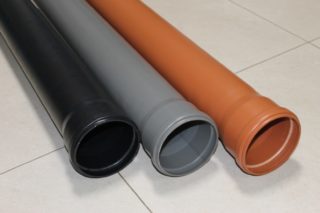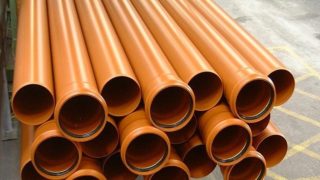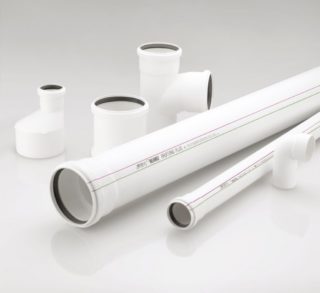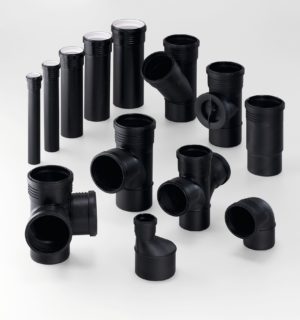Color coding is used to indicate the types of pipes used in certain conditions. When choosing, the location of the pipeline is taken into account, whether it is inside or outside the house, climatic conditions and temperature differences during operation.
Gray
- capable of passing liquid, the temperature of which does not exceed 60-75aboutC, withstand for a short time 90-95aboutFROM;
- the temperature of the room where the pipe is located should not fall below 0aboutFROM;
- during operation they do not corrode and do not emit substances harmful to health;
- deformed with a slight effort of 50-75 kgf / sq.m., the thickness of the polypropylene wall is 2.7 mm;
- not used for underground laying;
- differ in low cost.
The most common type of pipes is suitable for laying a part of the sewage system that runs inside the house, due to the fact that the technological characteristics of the material fully meet the requirements. It is not recommended to use this type of product when forming an external pipeline.
Redheads
Products are made from polyvinyl chloride. Pipes are divided into strength classes, according to which the magnitude of the load varies:
- class L withstands loads up to 2 kN / m2;
- class N withstands loads up to 4 kN / m2;
- class S withstands loads up to 8 kN / m2.
Also, red-colored products are classified by wall thickness:
- SN4 is 3.0mm thick;
- SN8 is 3.3mm thick.
The PVC pipeline does not tolerate temperature increases, while the operating range is limited to 40-60aboutC. Nevertheless, the negative temperature of the external environment does not in any way affect the characteristics of the material.
Ginger products are able to withstand the weight of the soil when laying the pipeline to a depth of 2 to 8 meters, depending on the class of the pipe. It is not recommended to install structures under roads, as there is a high probability of deformation, which can lead to sedimentation in the wastewater and the formation of congestion.
Red pipes have a number of disadvantages:
- the ability of destruction under the influence of acidic and oil effluents;
- as the temperature rises, the PVC pipe begins to lengthen.
The pipes are made smooth or corrugated. Corrugated products have a large surface area, therefore, due to the redistribution of pressure from the ground, they show increased resistance to loads. The cost of this category of pipes is slightly higher than gray products for indoor use.
Green
Products painted green are used for installing a drainage system underground. A distinctive feature of green pipes is the ability to bend when the soil subsides. At the same time, the pipes show resistance to temperature changes. The surface of the product has perforations that allow moisture to penetrate inside. Manufactured products are sometimes equipped with a layer of geotextile that acts as a filter.
White
Pipes are distinguished by their ability to withstand water temperatures up to 95aboutC. Produce products with a diameter ranging from 32 to 150 mm, while the length of the pipe segment is from 15 cm to 5 m. To help with installation, manufacturers place a scale in centimeters on the outer surface of their products. This greatly simplifies the process of determining the size of the segment when installing a sewer.
Black
Polyethylene sewer parts are able to withstand large volumes of liquid passing through pipes. A feature of the products is their size - most often the indicator is in the range from 250 to 850 mm. At the same time, there are also more voluminous pipes with significant fluid permeability.
There are some advantages of polyethylene black pipes:
- manifestation of resistance to water hammer;
- absence of corrosion when exposed to active substances;
- the service life can last up to 50 years.
The strength of the presented products is achieved by the production of corrugated walls from the inside, while the outside of the pipes remains smooth. The temperature of wastewater passing through the pipes should not be higher than 60aboutFROM.
Another area of use for black polyethylene pipes is to protect cables from moisture when laying underground. White pipes are also used when installing a drainage system. They are easy to recognize by the holes located on the walls of the products.
The cost of the presented parts of the sewerage system is relatively low with a rather long service life of polyethylene. It does not lend itself to temperature extremes and corrosion, and for a device as a sewer element does not require the use of a special tool.












